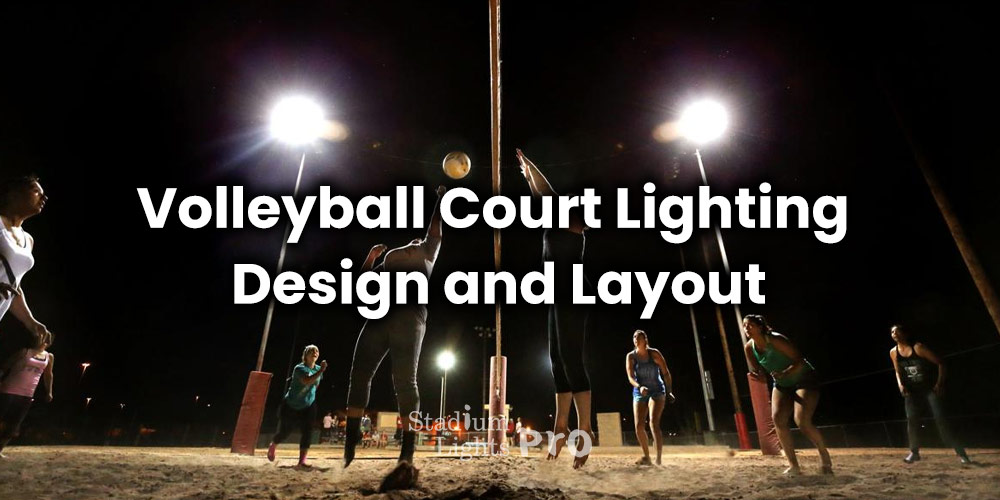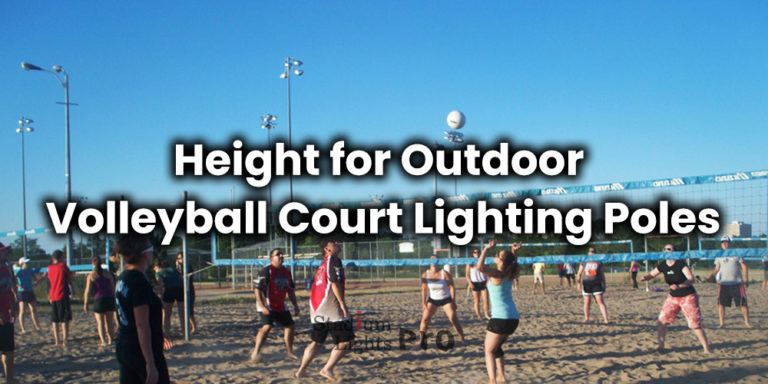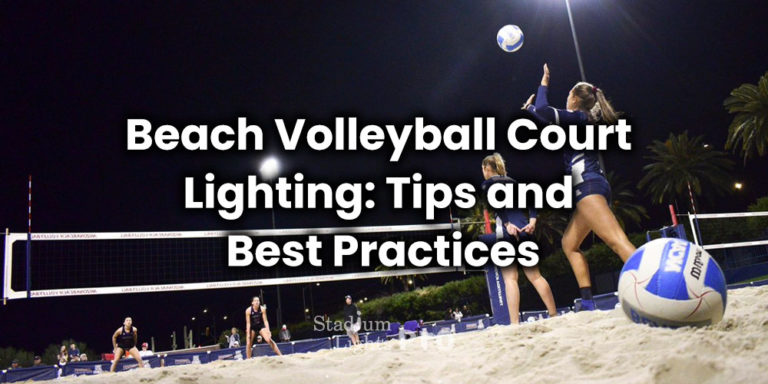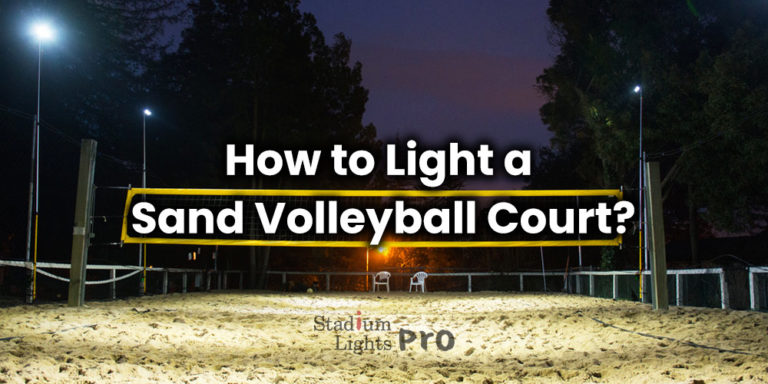Volleyball is a team sport in which two teams of six players each try to score points by hitting a ball back and forth over a high net. The ball is hit by players using their hands or arms, and the game is played on a court divided into two halves by a net. Volleyball is popular worldwide, with millions of players and fans.
Proper lighting allows players to see the ball and each other clearly, and it helps to reduce the risk of injuries. Poor lighting can cause players to misjudge the flight of the ball, leading to collisions and falls. In addition, poorly lit courts can be visually distracting and make it difficult for players and spectators to follow the action. Good lighting also enhances the overall viewing experience for spectators, making the game more enjoyable to watch.
Factors to consider when designing and layout out a volleyball court lighting system
Size and dimensions of the court
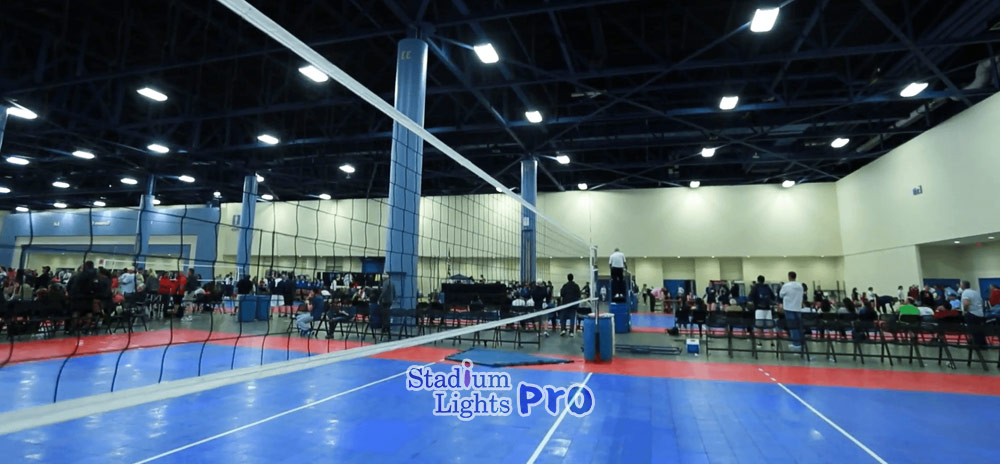
The size and dimensions of a volleyball court are standardized by the International Volleyball Federation (FIVB) and other governing bodies. The official dimensions of a volleyball court for international competition are:
- Length: 18 meters (59 feet)
- Width: 9 meters (29.5 feet)
- Height of the net: 2.43 meters (7 feet 11.5 inches) for men, 2.24 meters (7 feet 4 inches) for women, and 2.43 meters (7 feet 11.5 inches) for coed play
- Height of the antennae: 0.9 meters (2 feet 11.5 inches)
In addition to these dimensions, there are also zones on the court that players must adhere to during play. These include the attack line (also known as the “ten-foot line”), which is located 3 meters (9.8 feet) from the center of the net, and the service line, which is located 1.8 meters (5.9 feet) from the back boundary of the court. The official dimensions and zones of a volleyball court are marked by lines on the playing surface.
Illumination levels and uniformity required for play
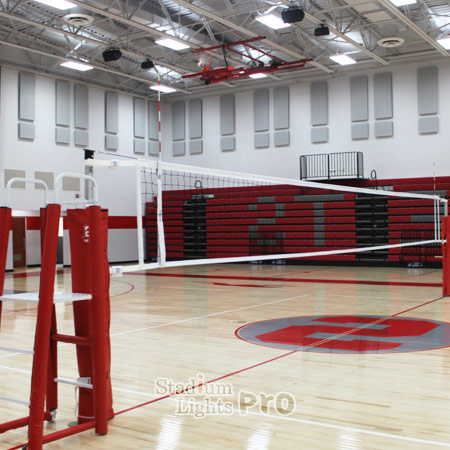 Adequate illumination is necessary for players to see the ball and each other clearly, while uniform lighting helps to reduce shadows and visual distractions on the court.
Adequate illumination is necessary for players to see the ball and each other clearly, while uniform lighting helps to reduce shadows and visual distractions on the court.
The FIVB recommends a minimum illumination level of 300 lux for indoor volleyball courts, with the ideal level being 500-700 lux. This can be achieved through a combination of overhead and perimeter lighting. For outdoor courts, the recommended minimum illumination level is 150 lux, with the ideal level being 250-350 lux.
In terms of lighting uniformity, the FIVB recommends that the ratio of minimum to maximum illumination on the court should be no more than 1:3. This means that the difference in illumination between the brightest and darkest areas of the court should not be more than three times the minimum illumination level.
Color temperature of volleyball court lights
For sports lighting applications, including for volleyball courts, it is generally recommended to use a color temperature of around 4000-5000K. This provides good visibility while minimizing eye strain.
Lower color temperatures, such as 2700K or 3000K, may be too warm and cause players to experience visual fatigue. Higher color temperatures, such as 6000K or higher, may be too cool and cause players to experience discomfort or difficulty seeing the ball.
Location and height of light fixtures
The height and location of the fixtures can affect the illumination levels on the court, as well as the amount of shadows and glare.
In general, light fixtures should be mounted as high as possible while still providing adequate coverage of the court. This helps to minimize shadows and allow the light to be more evenly distributed across the playing surface. The FIVB recommends a mounting height of at least 12 meters (39 feet) for indoor courts and at least 8 meters (26 feet) for outdoor courts.
In order to provide even illumination across the court, the fixtures should be placed around the perimeter of the playing area. This can be achieved through the use of pole-mounted fixtures or wall-mounted fixtures.
Glare and shadows on the court
Glare and shadows can be a problem on a volleyball court if the lighting is not properly designed and layout out. Glare is caused by light reflecting off of shiny or reflective surfaces, such as the ball or the playing surface, and can make it difficult for players to see the ball or each other. Shadows can be caused by objects or players blocking the light, and can also affect visibility on the court.
To minimize glare and shadows on a volleyball court, we need to consider the direction and intensity of the light. Light fixtures should be placed and angled in such a way as to minimize direct light on the court and players. The use of diffusers or other types of light-scattering materials can also help to reduce glare.
In addition, the use of perimeter lighting can help to reduce shadows on the court. This can be achieved through the use of wall-mounted fixtures or pole-mounted fixtures placed around the perimeter of the playing area.
Energy efficiency and cost considerations
Installing and operating a lighting system can be a significant expense for a sports facility. There are several ways to make a lighting system for a volleyball court more energy efficient and cost-effective. One option is to use energy-efficient light fixtures, such as LED or fluorescent fixtures, which use less electricity and have a longer lifespan than other types of fixtures.
Using fewer fixtures that provide adequate coverage of the court can help to reduce energy usage and cost. In addition, using fixtures with adjustable light levels or incorporating occupancy sensors can help to reduce energy usage when the court is not in use.
Types of light fixtures commonly used for volleyball courts
Metal halide
Metal halide lamps are a type of high intensity discharge (HID) light fixture that is commonly used for sports lighting, including for volleyball courts. These fixtures use a gas discharge process to produce light, and they are known for their high luminous efficiency and long lifespan.
Metal halide lamps is that they produce a bright, white light that is well-suited for sports lighting applications. They also have a relatively low operating cost, as they are energy efficient and have a long lifespan compared to other types of light fixtures.
However, they take a while to warm up and reach their full brightness, which can be a problem if the fixtures need to be turned on and off frequently. Metal halide lamps contain mercury, which makes them more difficult to dispose of than other types of light fixtures.
LED
LED (light-emitting diode) lamps are a type of energy-efficient light fixture that is becoming increasingly popular for sports lighting, including for volleyball courts. LED lamps use a semiconductor to convert electricity into light, and they are known for their long lifespan, low energy usage, and low maintenance requirements.
One of the main advantages of LED volleyball court light is their energy efficiency. They use significantly less electricity than other types of light fixtures, which can result in significant cost savings over time. LED lamps also have a long lifespan, typically lasting several years or more before needing to be replaced.
In addition to their energy efficiency and long lifespan, LED lamps also produce a bright, white light that is well-suited for sports lighting applications. They are also able to be dimmed or controlled remotely, which can be useful for adjusting light levels or turning the lights on and off.
However, LED can be more expensive upfront than other types of light fixtures. Some people find the quality of light produced by LED lamps to be less warm or natural-looking compared to other types of light sources.
Fluorescent
Fluorescent lamps are a type of light fixture that uses a gas discharge process to produce light. They are commonly used for indoor lighting applications, including for sports facilities such as volleyball courts.
Fluorescent lamps are known for their energy efficiency and long lifespan. They use significantly less electricity than other types of light fixtures, and they can last several years or more before needing to be replaced. In addition, they produce a bright, white light that is well-suited for sports lighting applications.
Yet, they contain mercury, which makes them more difficult to dispose of than other types of light fixtures. Besides, some people find the quality of light produced by fluorescent lamps to be less warm or natural-looking compared to other types of light sources.
High pressure sodium
High pressure sodium (HPS) lamps are a type of high intensity discharge (HID) light fixture that is commonly used for outdoor sports lighting, including for volleyball courts. These fixtures use a gas discharge process to produce light, and they are known for their high luminous efficiency and long lifespan.
HPS lamps produce a bright, yellow-orange light that is well-suited for outdoor sports lighting applications. They also have a relatively low operating cost, as they are energy efficient and have a long lifespan compared to other types of light fixtures.
However, HPS take a while to warm up and reach their full brightness, which can be a problem if the fixtures need to be turned on and off frequently. Moreover, HPS lamps contain mercury, which makes them more difficult to dispose of than other types of light fixtures.
Conclusion
Lighting is essential for volleyball courts to allow players to see the ball and each other clearly, and to reduce the risk of injuries.
At our company, we offer free volleyball court lighting design services and discounted pricing on our sports lighting fixtures. If you are in need of a new lighting system for your volleyball court, please don’t hesitate to contact us. Our team of lighting experts would be happy to help you design a system that meets the specific needs of your court and budget.
Whether you are looking to upgrade an existing volleyball lighting system or install a new one, we have a range of options available to suit your needs. Please don’t hesitate to reach out to us for more information or to request a quote. We look forward to helping you create a lighting system that enhances the playing and viewing experience for your players and spectators.

